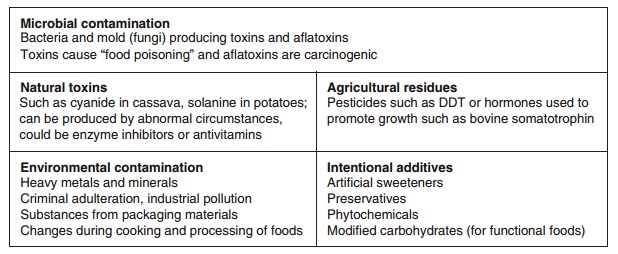Chapter: Introduction to Human Nutrition: A Global Perspective on Food and Nutrition
Future challenges for nutrition research and practice
Future challenges for nutrition research and practice
Basic, molecular nutrition
The tremendous development in recent years of molecular biology and the availability of sophisticated new techniques are opening up a field in which nutrient–gene interactions and dietary manipulation of genetic expression will receive increasing attention. The effects of more than 12 000 different substances in plant foods, not yet classified as nutrients, will also be examined. These substances are produced by plants for hormonal, attractant, and chemoprotective purposes, and there is evidence that many of them offer protection against a wide range of human conditions. It is possible that new functions of known nutrients, and even new nutrients, may be discovered, described, and applied in the future.
Clinical and community nutrition
Today, the focus has moved from simple experiments with clear-cut answers to studies in which sophisti-cated statistics have to be used to dissect out the role of specific nutrients, foods, and diets in multifactorial diseases. Nutrition epidemiology is now established as the discipline in which these questions can be addressed. A number of pressing problems will have to be researched and the results applied, for example:
● the biological and sociological causes of childhood obesity, which is emerging as a global public health problem
● the nutrient requirements of the elderly: in the year 2000, more than 800 million of the Earth’s inhabit-ants were older than 60 years; to ensure a high-quality life in the growing elderly population, much more needs to be known about their nutrient requirements
● the relationships between nutrition and immune function and how improved nutrition can help to defend against invading microorganisms; in the light of the increasing HIV/AIDS pandemic, more information in this area is urgently needed
● dietary recommendations: despite sufficient, con-vincing evidence about the effects of nutrients and foods on health, nutritionists have generally not been very successful in motivating the public to change their diets to more healthy ones. We need to know more about why people make certain food choices in order to design culturally sensitive and practical dietary guidelines that will impact posi-tively on dietary choices. The food-based dietary guidelines that are now being developed in many countries are a first step in this direction.
Public health nutrition
The single most important challenge facing mankind in the future is probably to provide adequate safe food and clean water for all in an environmentally safe way that will not compromise the ability of future generations to meet their needs. In addition to the hundreds of millions not eating enough food to meet their needs for a healthy, active life, an additional 80 million people have to be fed each year. The challenge to feed mankind in the future calls for improved agriculture in drought-stricken areas such as sub-Saharan Africa, the application of biotechnology in a respon-sible way, interdisciplinary and intersectorial cooperation of all involved, and a better distribution of the food supply so that affordable food is accessible by all. The need for sustained economic growth in poor countries is evident.
Nutritionists have an important part to play in ensuring food security for all, a basic human right, in the future. One of their main functions would be to educate and inform populations not to rely too heavily on animal products in their diet, the production of which places a much heavier burden on the environment than plant foods. A major challenge would be to convince political leaders and governments that addressing undernutrition (the major obstacle in national development) in sustainable pro-grams should be the top priority in developing and poor communities. Another challenge is to develop models based on the dynamics within communities and, using a human rights approach, to alleviate undernutrition without creating a problem of over-nutrition. There are examples where such models, incorporated into community development pro-grams, have been very successful (e.g., in Thailand).
Functional foods: a new development
Functional foods are new or novel foods, developed to have specific health benefits, in addition to their usual functions. Examples are spreads with added phytosterols, to lower serum low-density lipoprotein cholesterol and the risk of coronary heart disease, and the development of starchy products with resistant starch and lower glycemic indices, to help control blood glucose levels. The development and testing of functional foods is an exciting new area. These foods may help to improve or restore nutritional status in many people. However, much more should be known about suitable biomarkers to test their efficacy, vari-ability in human response to specific food products, safety, consumer understanding, and how their health messages must be formulated, labeled, and communicated.
Food safety
The continued provision of safe food, free from microorganisms, toxins, and other hazardous sub-stances that cause disease, remains a huge challenge. Recent experiences with animals suffering from bovine spongiform encephalopathy (BSE or mad cow disease) or from foot-and-mouth disease, or birds infected with the influenza A virus (bird flu), have shown how quickly a national problem can become an interna-tional one because of global marketing of products. The list of possible hazardous substances in foods emphasizes the need for continuous monitoring of the food supply by health officials (Figure 1.3).

Figure 1.3 Potential hazardous substances in food. DDT, dichloro-diphenyl-trichloroethane.
Related Topics